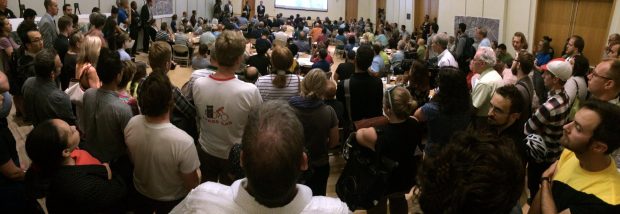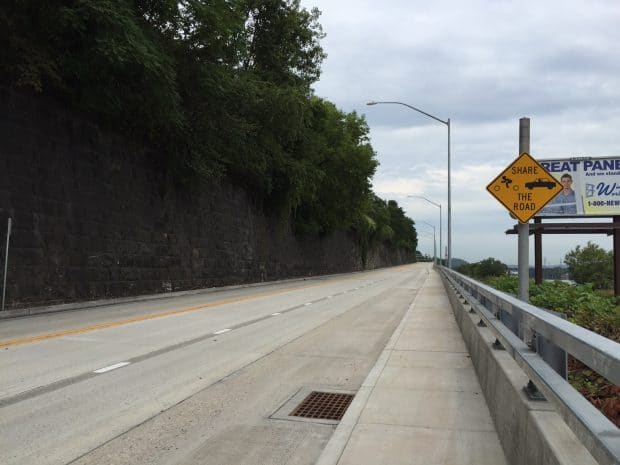
Standing-room only at PennDOT’s public meeting at CMU on Wednesday, August 31, 2016.
What’s Working and What’s Not
Response to this week’s meeting at Carnegie Mellon University regarding design changes planned for Forbes Avenue have been particularly strong, but there seems to be some confusion about what we support, what we don’t, what’s working, and what’s not.
The meeting was mainly an opportunity for PennDOT and CMU to report back to the redesign of Forbes Avenue between Craig Street and Beeler Street, but many other issues ended up being aired. It’s been a bad week for the BikePGH community and there was certainly a lot frustration in the room. With so many opinions and issues out there, we want to set the record straight.
First things first, the original intent of the meeting was to focus on Forbes Avenue between Beeler and Craig. Regarding those design changes, we want to commend the nearby residents, CMU, PennDOT, Mayor Peduto, and Councilman Gilman for developing a quality plan that meets most of the needs of all of the stakeholders. BikePGH was an active advisor and participant and we’re proud of our role in helping to create a great plan.
We’d still like to suggest a handful of tweaks to the CMU plan, but it’s tremendous progress and exactly the kind of dialogue that keeps things moving ahead. This works and we support it. Unfortunately, during the meeting, PennDOT’s Forbes Avenue Betterment Project, which includes a larger section of Forbes Avenue from Craig Street to the Birmingham Bridge, ended up being conflated with the work through the CMU campus section of Forbes.
It’s important to acknowledge that BikePGH has been working on making Oakland bike-friendly since 2002, the year we began as an organization. Here is a quickly made list of our participation and leadership in various Oakland plans and meetings that we can recall:
- Attempting back in 2004/2005 to get OTMA and the City of Pittsburgh to incorporate bikeways into their federal Hometown Streets project that was focused on putting curb bump outs throughout the corridor. We didn’t win, but we learned how the funding and project letting worked.
- Coordinating one to two Urban Cycling Committee Meetings per month with City Planning and DPW for the past 10 years.
- Authoring our rudimentary Universities Connect Plan, laying out the problem at hand, way back in 2006.
- With the blessing from the Oakland Task Force in 2008, working on an experimental route, termed the Oakland Green Route, that used Iroquois Way, Sennott Street, and a parking lot that connected the two. Due to complications from public safety, to sanitation services, driveways, and a parking lot owner who would not oblige, the project failed. This pointed us again to the critical importance of making Fifth and Forbes bike-friendly.
- Turning our members out to the PCTI Fifth/Forbes meetings in 2010/2011.
- Helping to coordinate Think Bike, a program of the Dutch Ministry of Foreign Affairs, to study Oakland in terms of bikeability in 2012.
- Serving on OPDC’s Community Planning Process for the Oakland 2025 Plan.
- Supporting the Oakland Bike/Ped Committee, a.k.a. the Oakland Green Team.
- Helping to coordinate the launch of Bike Share and the locations of its stations.
- Coordinating and installing bike racks throughout the Oakland business district.
- Helping to get the CMU Bike/Ped Committee started.
- Assisting with the City of Pittsburgh’s CMAQ grant request for Oakland bikeways
- Serving on the stakeholder committee for the Bus Rapid Transit project, getting the County to agree to install bike lanes with the (un)planned BRT project that has been holding Fifth and Forbes hostage for the past five years.
- Authoring the Better Bikeways Vision, prominently featuring protected bike lanes on Forbes, that the Mayor signed on to and has referenced often.
- Attending public meetings related to CMU’s Master Planning Process.
- Hosting several pop-up bike light giveaways in Oakland.
- Co-hosting Bike to Work Day celebrations in Oakland starting in 2002 and continuing through 2016.
- Contributing actively on EcoInnovation District Planning and Committees.
- Serving on the Louisa Street Redesign Committee.
- Working with City Planning and DPW to install the first protected bike lanes on Schenley Drive and Saline Street, literally paying for some of the equipment from a grant that we coordinated with People for Bikes. This followed up with us coordinating one thousand personal “thank yous” to Mayor Peduto that we hand-delivered.
- Working with City Planning and DPW to install bike lanes on Bigelow, O’Hara, Bayard, and Bouquet.
- Working with City Planning and DPW to turn Pocusset Street into an exclusively bike/ped street.
- Working with City Planning and DPW to install the City’s first runnel on the Louisa Street steps.
- Participating in a 2014 trip that took Mayor Peduto and Allegheny County Executive Rich Fitzgerald to Copenhagen to see and experience exactly what Oakland could look like, including a presentation that included Oakland.
- Holding many one-on-one meetings with Bob Reppe, CMU’s planner, about bike lanes near CMU (note: there has not been a public meeting on street design around CMU since the PCTI project years earlier).
- Leading Action for a Safe Fifth/Forbes, which generated thousands of petition signatures after Susan Hicks was killed.
It’s been a slow, long, and integrated process throughout every aspect of Oakland life and planning and we’ve been committed to working with Mayor Peduto, the universities, OPDC, and as many stakeholders as we can engage in this important work I think we can all agree, this works.
As much as we’re committed to be a coalition-builder, we cannot apologize for being aggressive in advancing our work. As hard as we’ve all been working, we’re still behind and have so much to do. In fact, maybe we haven’t been aggressive enough. We have tried for 15 years to be the organization at the table, rationally explaining why it is important to plan for people who walk and bike. We have a supportive Mayor and County Executive, but still encounter a lot of resistance from PennDOT. Most of it’s a cultural thing. They were trained to move cars through an area as quickly as possible. We often seem to be speaking different languages—we want to talk about safe, connected multimodal options—but too often we end up with conventional designs that prioritize cars over people.
We’ve learned PennDOT’s language: level of service, turning radii, throughput, etc. We try to understand the constraints and requirements put on them by the federal government. We’re hoping that they’re as committed to understanding our language—the language of context sensitivity, of equitable access, of multimodal design using the most up-to-date urban standards. Unfortunately, meanwhile, we keep getting hit and injured and killed on their roads. This isn’t working.
Maybe we’ve been too deferential to PennDOT and maybe that’s how a $22 million dollar West Carson Street PennDOT project ballooned to $39 million, and then went an additional $3 million over budget, and still didn’t deliver bikeways in the final product. We gave it our best shot, but it takes an active listener on the other side. This isn’t working.

West Carson Street on Wednesday, August 31, 2016, a day after Dennis Flanagan’s death.
A week after their brand new highway opened with 14-foot lane widths, bicyclist Dennis Flanagan was killed while riding on it. His tragic death happened to coincide with a PennDOT public meeting for another critically important road they own, where Susan Hicks was killed last year while riding her bike. While we have written them letters of record and turned hundreds of people out to their meetings, they only choose to accommodate bikes when it’s easy and convenient for them to do so. While it’s no problem to pour an additional $20 million into their projects for cars, they would never imagine adding close to that amount to accommodate multimodal transport. Their decisions impact our lives for decades, and yet all we get to do is tell them what we think and try our best to hold them accountable for their decisions. This is not working.
Overall, we’re very encouraged by the bike lane designs around Carnegie Mellon’s campus. However, PennDOT’s Forbes Avenue Betterment Project, which BikePGH and the City of Pittsburgh only learned of from PennDOT following Susan Hicks’ death, does not connect bike lanes to current infrastructure or future plans. Although we do not currently support the Forbes Avenue Betterment Project as it was presented on Wednesday night, we do see enormous opportunities to improve safety and connectivity for biking and walking between Oakland and Downtown within this project.
Thousands of Pittsburghers have contributed time, money and spirit to Bike Pittsburgh so that we as a community of bicyclists and pedestrians can achieve more effective results. At Wednesday’s meeting, our intention was to get results from PennDOT, to keep us safe while using the roads they control, and which we own as Pennsylvania taxpayers.
5 Comments
Link to message board thread on the topic.
http://bikepgh.org/message-board/topic/public-meeting-aug-31-forbes-ave-redesign-and-bike-lanes/
A link to this post was added there, as well.
Bravo!
test
[…] Despite what some may say, BikePGH is in support of the project, but we do believe it can be even better. We think that the team’s goal of accommodating all users in this corridor is the right path. As the project also coincides with PennDOT’s Forbes Ave Betterment Project, which will be repaving the road to the the Birmingham Bridge, we feel that there are opportunities that we would not want the team to overlook. […]
[…] you may recall, at the packed August 31 public meeting discussing planned bike lanes on Forbes Avenue through CMU’s campus, people were rightfully […]